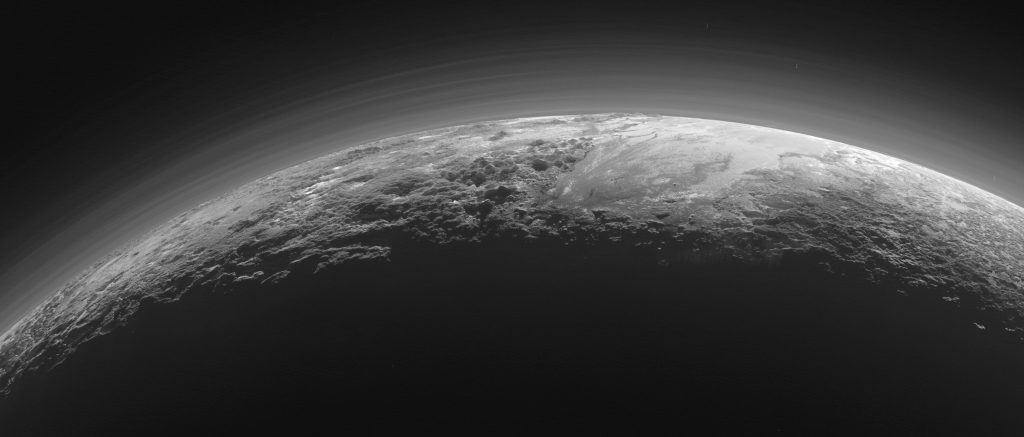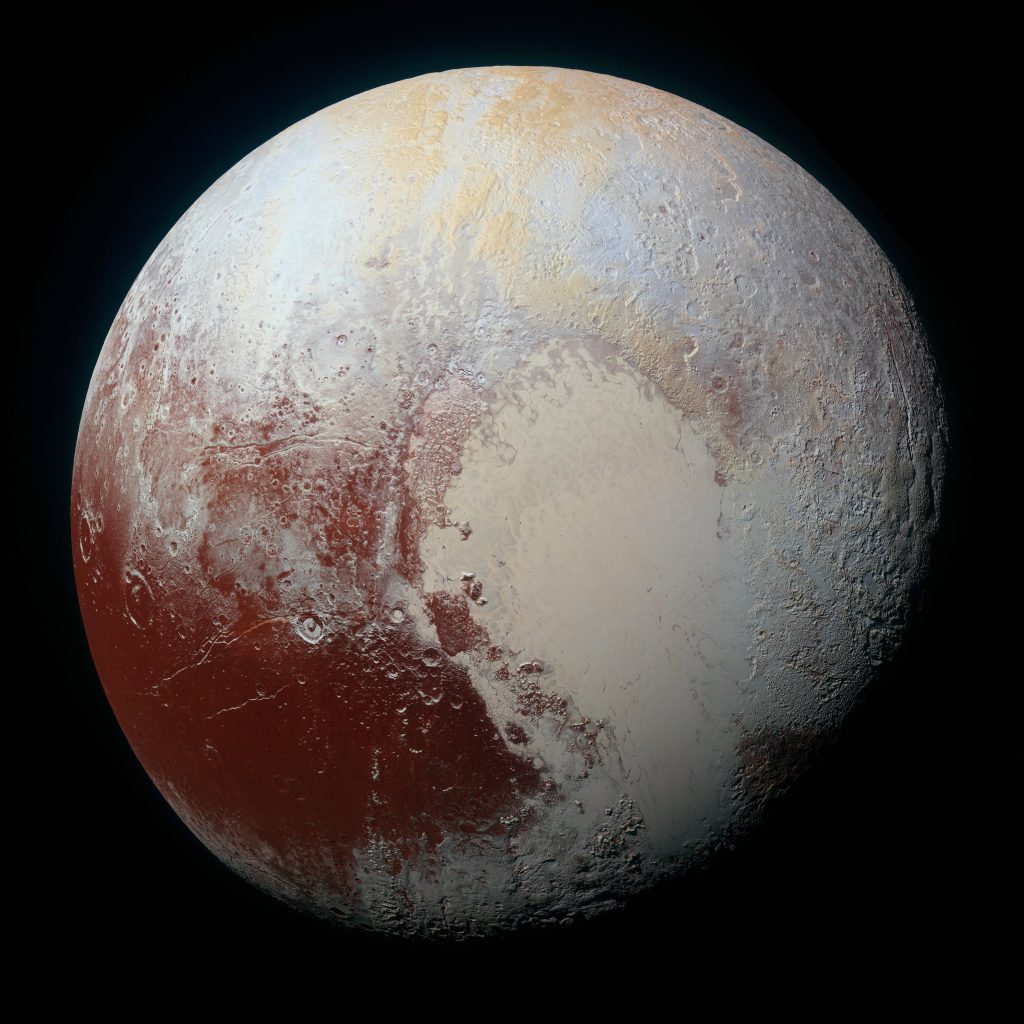8.4 Pluto and Charon
Almost everything we know about Pluto and its moons comes from the New Horizons spacecraft, which flew by in 2015 before travelling on into the outermost parts of the planetary system. Using data from the New Horizons probe, astronomers have measured the diameter of Pluto as 2370 kilometres, only 60 percent as large as our Moon. From the diameter and mass, we find a density of 1.9 g/cm3, suggesting that Pluto is a mixture of rocky materials and water ice in about the same proportions as many outer-planet moons.
Parts of Pluto’s surface are highly reflective, and its spectrum demonstrates the presence on its surface of frozen methane, carbon monoxide, and nitrogen. The maximum surface temperature ranges from about 50 K when Pluto is farthest from the Sun to 60 K when it is closest. Even this small difference is enough to cause a partial sublimation (going from solid to gas) of the methane and nitrogen ice. This generates an atmosphere when Pluto is close to the Sun, and it freezes out when Pluto is farther away. Observations of distant stars seen through this thin atmosphere indicate that the surface pressure is about a ten-thousandth of Earth’s. Because Pluto is a few degrees warmer than Triton, its atmospheric pressure is about ten times greater. This atmosphere contains several distinct haze layers, presumably caused by photochemical reactions, like those in Titan’s atmosphere (Figure 8.22).
Haze Layers in the Atmosphere of Pluto

PIA19948: Pluto’s Majestic Mountains, Frozen Plains and Foggy Hazes by NASA/Johns Hopkins University Applied Physics Laboratory/Southwest Research Institute, NASA Media Licence.
Reaching Pluto with a spacecraft was a major challenge, especially in an era when reduced NASA budgets could not support large, expensive missions like Galileo and Cassini. Yet like Galileo and Cassini, a Pluto mission would require a nuclear electric system that used the heat from plutonium to generate the energy to power the instruments and keep them operating far from the warmth of the Sun. NASA made available one of the last of its nuclear generators for such a mission. Assuming an affordable but highly capable spacecraft could be built, there was still the problem of getting to Pluto, nearly 5 billion kilometres from Earth, without waiting decades. The answer was to use Jupiter’s gravity to slingshot the spacecraft toward Pluto.
The 2006 launch of New Horizons started the mission with a high speed, and the Jupiter flyby just a year later gave it the required additional boost. The New Horizons spacecraft arrived at Pluto in July 2015, travelling at a relative speed of 14 kilometres per second (or about 50,000 kilometres per hour). With this high speed, the entire flyby sequence was compressed into just one day. Most of the data recorded near closest approach could not be transmitted to Earth until many months later, but when it finally arrived, astronomers were rewarded with a treasure trove of images and data.
Pluto is not the geologically dead world that many anticipated for such a small object—far from it. The division of the surface into areas with different composition and surface texture is apparent in the global colour photo shown in Figure 8.23. The reddish colour is enhanced in this image to bring out differences in colour more clearly. The darker parts of the surface are cratered, but adjacent to them is a nearly featureless light area in the lower right quadrant of this image. This is a huge ice-filled depression called the Sputnik Plains, named for the first artificial Earth satellite. The absence of impact craters suggests a surface no more than 10 million years old. The dark areas show the colours of photochemical haze or smog similar to that in the atmosphere of Titan. The dark material that is staining these old surfaces could come from Pluto’s atmospheric haze or from chemical reactions taking place at the surface due to the action of sunlight.
Global Colour Image of Pluto

PIA19952: The Rich Colour Variations of Pluto by NASA/Johns Hopkins University Applied Physics Laboratory/Southwest Research Institute, NASA Media Licence.
Figure 8.24 shows some of the remarkable variety of surface features New Horizons revealed. we are finding on Pluto. Toward the right on this image, we see the shoreline of the Sputnik Plains, showing evidence of relatively recent geological activity. The nitrogen and carbon monoxide ice that fills the Sputnik depression shows cells or polygons with an average width of more than 30 kilometres, caused by slow convection in the ice.
Surface of Pluto

PIA20213: Pluto’s Close-up, Now in Colour by NASA/Johns Hopkins University Applied Physics Laboratory/Southwest Research Institute, NASA Media Licence.
Figure 8.25 shows another view of the boundary between different types of geology. The width of this image is 250 kilometres, and it shows dark, ancient, heavily cratered terrain; dark, uncratered terrain with a hilly surface; smooth, geologically young terrain; and a small cluster of mountains more than 3000 metres high. In the best images, the light areas of nitrogen ice seem to have flowed much like glaciers on Earth, covering some of the older terrain underneath them.
The isolated mountains in the midst of the smooth nitrogen plains are probably also made of water ice, which is very hard at the temperatures on Pluto and can float on frozen nitrogen. Additional mountains, and some hilly terrain that reminded the mission scientists of snakeskin, are visible in part (b) of Figure 8.25.
Diversity of Terrains on Pluto

(a): PIA19933: Dark Areas by NASA/Johns Hopkins University Applied Physics Laboratory/Southwest Research Institute, NASA Media Licence.
(b): PIA19957: ‘Snakeskin’ Terrain by NASA/Johns Hopkins University Applied Physics Laboratory/Southwest Research Institute, NASA Media Licence.
To add to the mysteries of Pluto, we show in Figure 8.26 one of the best New Horizons images of Pluto’s large moon Charon. Charon is roughly half Pluto’s size (its diameter is about the size of Texas) and keeps the same side toward Pluto, just as our Moon keeps the same side toward Earth. What is unique about the Pluto-Charon system, however, is that Pluto also keeps its same face toward Charon. Like two dancers embracing, these two constantly face each other as they spin across the celestial dance floor. Astronomers call this a double tidal lock.
Pluto’s Large Moon Charon

(a): PIA19968: Charon in Enhanced Colour by NASA/Johns Hopkins University Applied Physics Laboratory/Southwest Research Institute, NASA Media Licence.
(b): PIA19713: Close-Up of Charon’s ‘Mountain in a Moat’ by NASA/Johns Hopkins University Applied Physics Laboratory/Southwest Research Institute, NASA Media Licence.
What New Horizons showed was another complex world. There are scattered craters in the lower part of the image, but much of the rest of the surface appears smooth. Crossing the center of the image is a belt of rough terrain, including what appear to be tectonic valleys, as if some forces had tried to split Charon apart. Topping off this strange image is a distinctly red polar cap, of unknown composition. Many features on Charon are not yet understood, including what appears to be a mountain in the midst of a low-elevation region.
Attribution
“12.4 Pluto and Charon” from Astronomy 2e by Andrew Fraknoi, David Morrison, Sidney C. Wolff, © OpenStax – Rice University is licensed under a Creative Commons Attribution 4.0 International License, except where otherwise noted.

